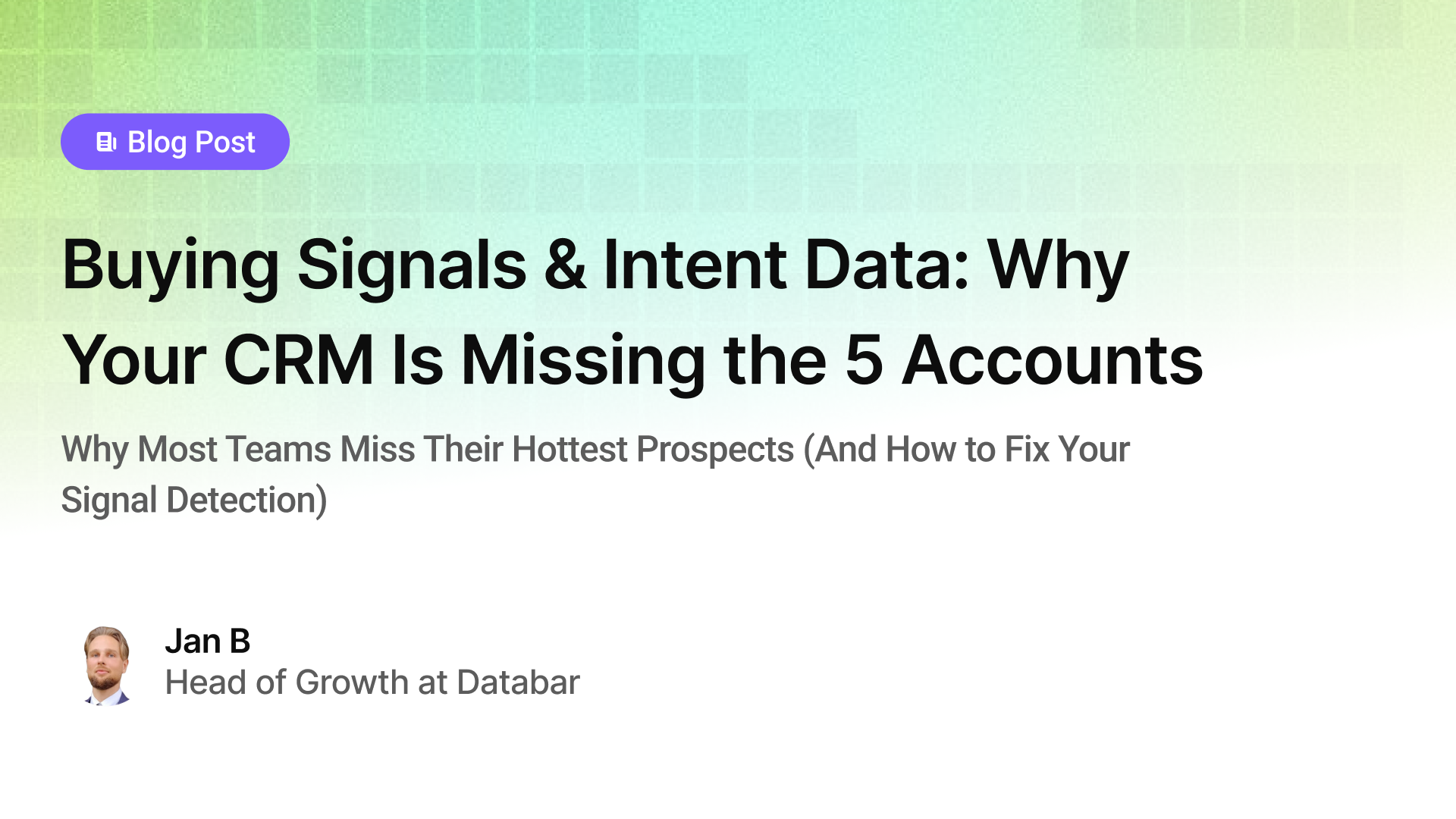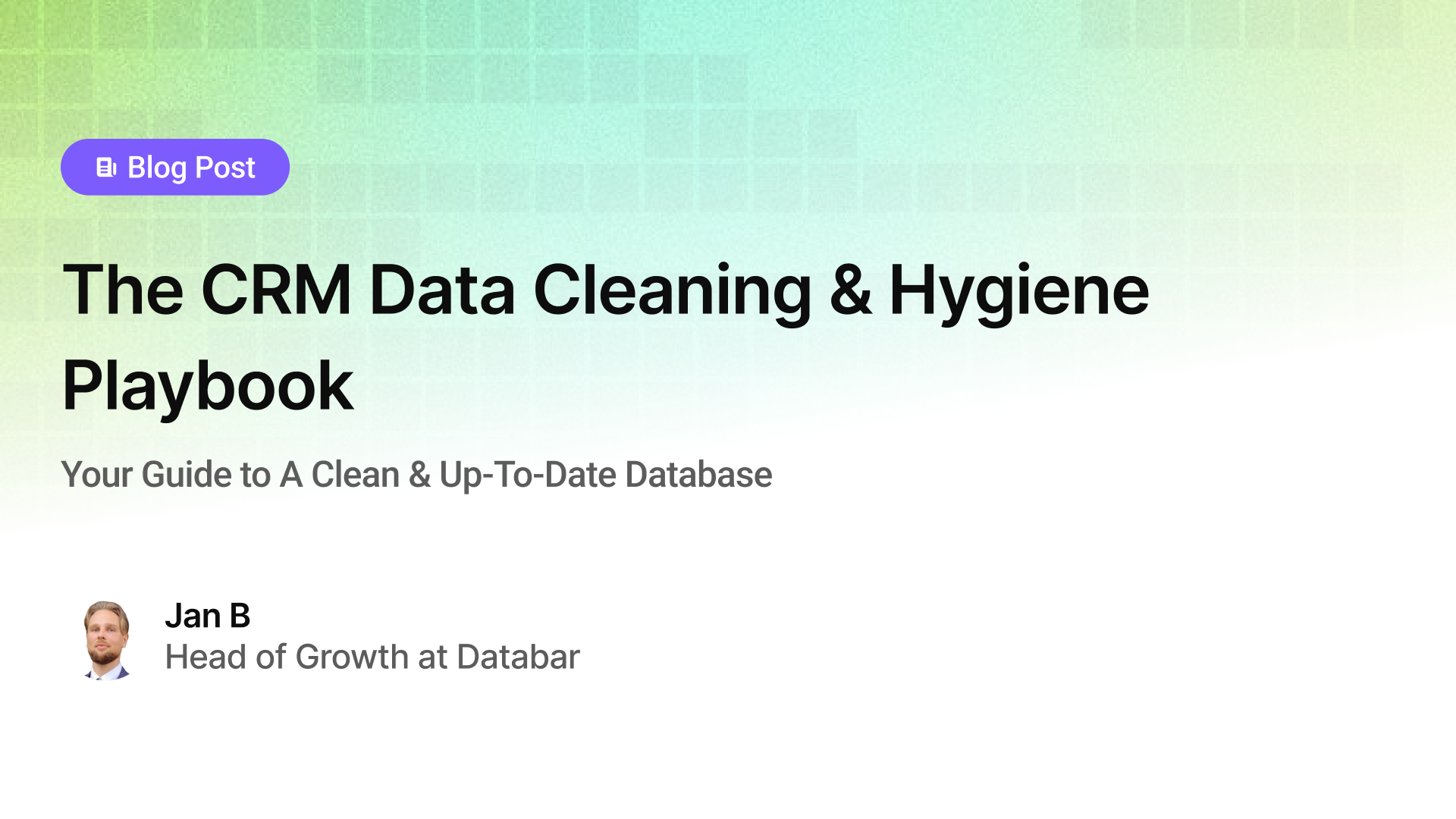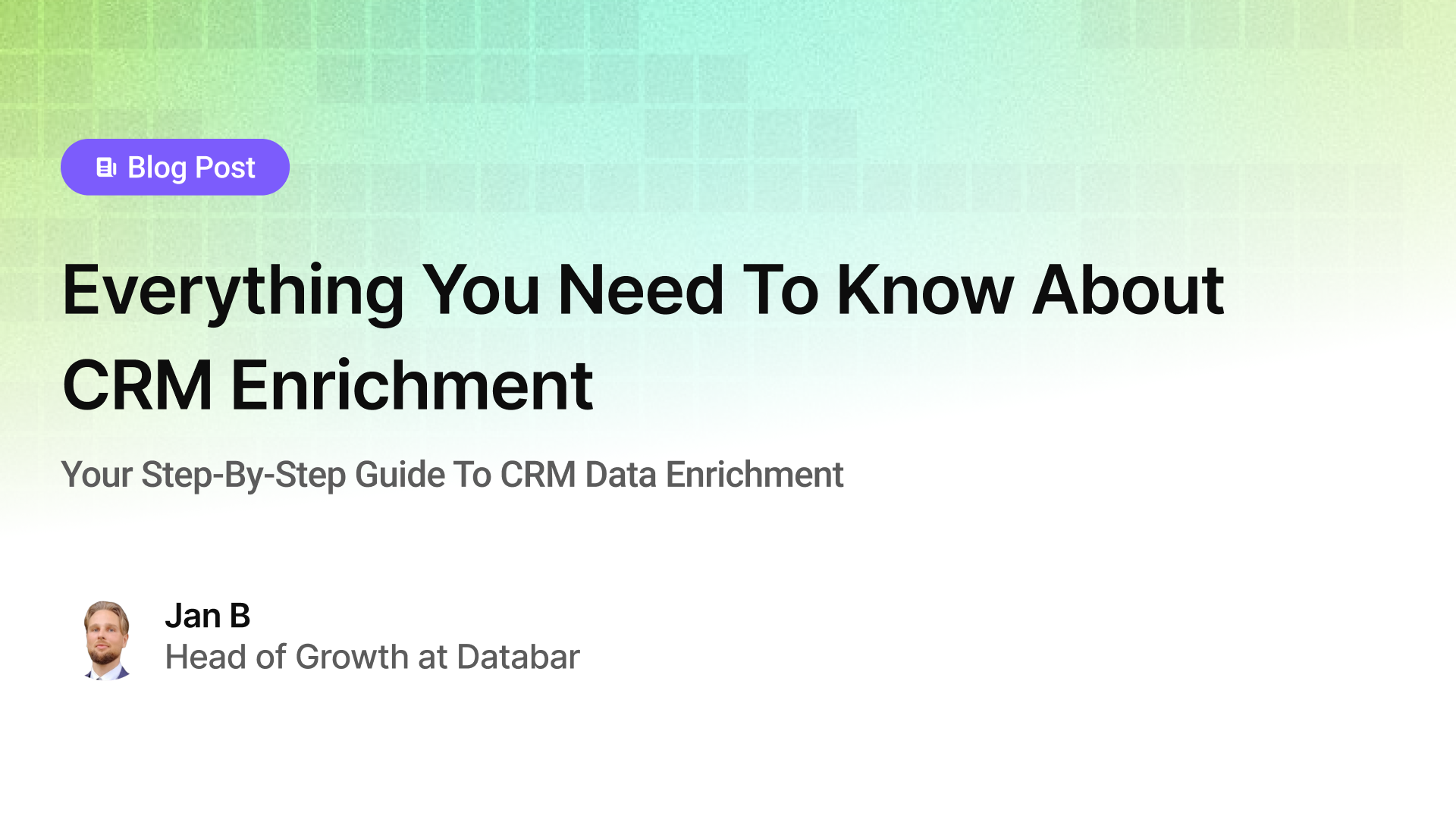Buyer Intent Signals: How to Capture, Interpret, and Convert High-Value Prospects
Beyond the Guessing Game: Why Buyer Intent Signals Change Sales
Blogby JanMay 19, 2025

Only 5% of B2B prospects are actively looking for your solution right now—but they drive 80% of your revenue.
Here's the cold truth: your sales team is probably spending countless hours pursuing prospects based on basic firmographics—company size, industry, job titles—while completely missing the critical signals that reveal which 5% are actually ready to buy.
In 2025, smart sales organizations don't just build bigger prospect lists. They identify who's in-market right now by tracking buyer intent signals.
These digital breadcrumbs—ranging from website behavior to organizational changes like funding events—reveal which prospects are actively considering solutions like yours, often before they've even reached out to any vendors.
This guide breaks down exactly how to capture, interpret, and act on buyer intent signals to transform your sales results—without increasing your team size or marketing budget.
Why Traditional Prospecting Falls Short in 2025
Before diving into the solution, let's understand why conventional prospecting approaches aren't enough anymore:
The Invisible Buyer Journey
The B2B buying process has fundamentally changed. Today, 67% of the buyer's journey happens digitally before a salesperson gets involved. Prospects research anonymously through multiple channels, gathering information and forming opinions without ever filling out a form or requesting a demo.
With 6-10 decision-makers typically influencing B2B purchase decisions, the buying process has become more complex and harder to track through traditional means. These digital interactions leave traces that reveal purchase intent long before explicit interest is shown.
This evolution means that waiting for prospects to fill out a form or respond to cold outreach is a strategy that misses the majority of in-market buyers.
The Wasted Effort Problem
Most sales teams operate with significant blind spots that undermine their effectiveness:
- Pursuing unqualified leads based solely on demographic fit
- Missing active buyers because they haven't raised their hands
- Reaching out with generic messaging that ignores buyer context
- Timing outreach based on sales quotas rather than buyer readiness
This approach results in wasted effort, poor conversion rates, and missed revenue opportunities—even when your target accounts are actively looking for solutions like yours.
What Are Buyer Intent Signals?
Buyer intent signals are digital behaviors and organizational indicators that reveal a prospect's likelihood to purchase. Unlike basic engagement metrics, true intent signals correlate strongly with actual buying decisions.
These signals fall into four main categories:
1. Research-Based Intent Signals
Research signals track how prospects are gathering information about potential solutions. These include content consumption patterns that reveal topic interests, search behaviors around specific solution categories, and competitor evaluations showing alternative assessment activities.
The value of these signals lies in their ability to show not just general interest, but specific areas of focus. A prospect repeatedly researching "data integration challenges" is revealing different intent than one focusing on "cost reduction strategies," even if both might eventually consider your solution.
Key research signals to track include:
- Industry-specific content engagement patterns
- Solution category search behaviors
- Competitor comparison research
- Webinar and event participation on relevant topics
2. Engagement-Based Intent Signals
Engagement signals reveal how prospects interact with your brand specifically. Website behavior, especially on high-intent pages like pricing or product specifications, provides clear indicators of evaluation.
The patterns of engagement often reveal more than individual actions. For example, a prospect who views your pricing page, then explores implementation documentation, then returns to pricing is showing a different level of intent than someone who briefly scans your homepage before leaving.
Most valuable engagement signals include:
- Multiple visits to pricing or product pages
- Time spent on technical documentation
- Engagement with ROI calculators or configuration tools
- Demo requests or direct inquiries about capabilities
3. Organizational Intent Signals
Organizational signals indicate readiness at the company level, providing critical context for individual behaviors. These organizational indicators often precede active solution research. A company that just raised Series B funding and is hiring a Head of Data Operations is likely to be in-market for data solutions in the near future, even before they've begun actively researching vendors.
These company-level signals help you identify buying windows before competitors are aware they exist. By tracking organizational changes alongside individual behaviors, you can identify accounts with both interest and ability to purchase.
Powerful organizational signals include:
- Recent funding events or financial announcements
- Executive team changes in relevant departments
- Strategic initiative launches aligned with your solution
- Technology implementation patterns that complement your offering
4. Competitive Intent Signals
Competitive signals show evaluation in comparison to alternatives, revealing where prospects are in their decision process. These signals provide valuable context about a prospect's current solution state and potential timeline.
Key competitive signals to monitor:
- Direct competitor research and comparison activities
- Review site engagement comparing solution options
- Contract renewal timing with existing vendors
- Research focused on migration or transition topics
How to Identify and Capture Buyer Intent Signals
Effectively capturing buyer intent requires a systematic approach. Here's how to build a comprehensive intent tracking system:
Map Your Buyer's Journey
Before tracking anything, document how your buyers typically progress from awareness to purchase. This mapping exercise creates a foundation for recognizing which signals indicate early, mid, or late-stage buying behavior.
For each journey stage, identify:
- Key questions prospects typically ask
- Resources they consult during evaluation
- Decision criteria they prioritize
- Stakeholders involved at each point
Understanding these progression patterns helps you interpret intent signals in their proper context, rather than treating all engagement equally. The same action—downloading a whitepaper, for instance—might indicate different intent depending on the prospect's role and previous interactions.
Implement Multi-Channel Signal Tracking
To capture a complete picture of intent, you need visibility across multiple channels that track different dimensions of buying behavior.
First-party intent tracking from your owned properties provides direct insight into how prospects engage with your brand specifically. This includes website analytics showing page visits and engagement patterns, marketing automation data tracking email and content interactions, and CRM data revealing direct communications.
Third-party intent tracking expands your visibility beyond your own properties to understand prospect activity across the broader web. This includes review site activity showing product research, technology scanning revealing stack changes, and publisher networks tracking relevant content consumption across industry publications.
Organizational intelligence adds crucial company context to individual behaviors, transforming isolated actions into meaningful patterns. This includes tracking funding announcements and financial events, executive changes and organizational restructuring, and strategic initiative launches that might create buying opportunities.
The most effective intent tracking combines all three dimensions to create a complete picture of both individual interest and organizational readiness. This multi-channel approach prevents the blind spots that occur when relying on a single signal type.
Build a Nuanced Scoring System
Not all intent signals carry equal weight when it comes to predicting purchase likelihood. Develop a scoring model that considers multiple factors:
- Signal strength: How closely the action correlates with purchase decisions
- Signal recency: How recently the behavior occurred
- Signal frequency: How often the behavior has been repeated
- Signal source: Where the behavior was observed
- Signal context: Who performed the action and in what circumstances
The most sophisticated scoring systems weight combinations of signals higher than individual actions. Your scoring model should be calibrated based on historical conversion data whenever possible. Analyze which signals or signal combinations most reliably predicted purchases in the past, and adjust your scoring weights accordingly.
Create Real-Time Alert Systems
Some high-value intent signals deserve immediate attention, making real-time alerting a critical component of an effective intent strategy. The goal is alerting your team to the right opportunities at the right time—when interest is at its peak and before competitors have engaged.
Configure your system to notify sales reps when:
- Target accounts show sudden spikes in research activity
- Multiple stakeholders from the same company engage with your content
- Prospects exhibit late-stage buying behaviors like pricing research
- Organizational events create timely opportunity windows
These real-time notifications allow for immediate follow-up during critical decision windows, dramatically increasing engagement and conversion rates.
Converting Intent Signals Into Personalized Outreach
Capturing intent data is only valuable if you can turn those insights into effective sales conversations. Here's how to translate signals into personalized outreach:
Tailor Messaging to Specific Intent Signals
Different signals should trigger different types of outreach, with messages that directly acknowledge the observed behavior and its business context. For research-based signals showing active solution exploration, focus on addressing the specific topics or challenges they're researching. Connect these interests to relevant capabilities or outcomes your solution provides, using similar language to what they've been searching for.
Sample messaging approaches for different signal types:
For Research-Based Signals:
"I noticed your team has been exploring [specific topic] recently. Many [industry] leaders facing [related challenge] have found our approach particularly effective. Would you find value in seeing how [similar company] addressed this with a 43% improvement in [relevant metric]?"
For Engagement-Based Signals:
"Your interest in our [specific resource] caught my attention. The [key feature] you explored has been especially valuable for companies dealing with [specific pain point]. I'd be happy to walk you through how it works in more detail or answer any questions about implementation."
For Organizational Signals:
"Congratulations on your recent [funding round/expansion/initiative]. As you scale your [relevant department], you might be evaluating ways to [address specific challenge]. I'd love to share how we've helped similar companies during this growth phase."
In all cases, the key is connecting your outreach directly to the observed behavior and business context, showing prospects you understand their specific situation rather than sending templated messages.
Time Outreach Based on Intent Urgency
Different signals indicate different levels of urgency, and your response timing should reflect this variation:
- High-urgency signals like pricing page visits or competitor comparison research warrant immediate response—ideally within minutes or hours
- Medium-urgency signals like multiple content downloads or repeated site visits merit prompt follow-up within 1-2 days
- Low-urgency signals like early research behaviors deserve a measured approach with value-focused outreach
Aligning your response timing with the prospect's apparent timeline shows respect for their process while ensuring you're present when they're ready to engage. This synchronized approach dramatically outperforms calendar-based outreach that ignores the prospect's actual buying journey.
Advanced Strategies for Maximizing Intent Data Value
Beyond basic signal tracking and response, several advanced strategies can dramatically improve your results:
Intent-Based Account Prioritization
Rather than treating all accounts equally, successful teams reorganize their target lists based on observed intent signals. This approach creates multiple tiers of priority that focus resources where they'll have the greatest impact.
This prioritization framework typically includes:
- Hot accounts: Showing multiple high-value intent signals across different stakeholders
- Warming accounts: Displaying early-stage research behaviors or relevant organizational changes
- Watching accounts: Target fit but no current intent signals observed
- Deprioritized accounts: Showing negative intent signals or competing priorities
This tiered approach ensures your team's time is concentrated on accounts most likely to convert in the near term, rather than spreading effort evenly across your entire target list regardless of buying readiness.
Buying Committee Mapping
For complex B2B sales, a single intent signal rarely tells the whole story. Advanced teams track engagement across entire buying committees to create a comprehensive view of the decision process.
This committee-level approach includes:
- Identifying all stakeholders involved in the decision process
- Tracking engagement patterns specific to each role
- Mapping content consumption to relevant responsibilities
- Determining influence levels based on organizational structure
This committee-level insight enables tailored outreach to different stakeholders based on their specific concerns and level of involvement. Rather than sending the same message to everyone, you can address the technical evaluator's implementation questions separately from the economic buyer's ROI concerns.
The buying committee view also reveals gaps in your engagement coverage. If key stakeholders aren't showing any activity, you can proactively develop strategies to reach them through existing connections or targeted content.
Avoiding Common Intent Signal Pitfalls
Even sophisticated companies sometimes fall into common traps that undermine their intent-based strategies:
Signal Misinterpretation
Not all engagement indicates genuine buying intent. Companies must be careful not to misinterpret certain activities that mimic buying signals:
- Competitive research by rivals examining your offering
- Student or analyst research for academic or market analysis
- Current customer activity mistaken for new purchase interest
- Job seekers researching your company for employment opportunities
Proper filtering and context evaluation help distinguish between genuine buying signals and unrelated research activities. This typically requires combining multiple signal types rather than relying on isolated behaviors.
Delayed Response to Time-Sensitive Signals
Intent data loses value exponentially with time, making response speed critical to effectiveness. Many companies undermine their intent strategies through:
- Processing delays that result in week-old signals being actioned
- Approval bottlenecks requiring managerial review before outreach
- Batch processing that groups urgent and non-urgent signals together
- Manual workflows that can't scale with signal volume
Automated alerting and response systems ensure that high-value signals receive attention while interest is at its peak. These systems should include escalation protocols when initial response attempts don't receive engagement, ensuring persistent follow-up during critical decision windows.
Single-Channel Dependence
Relying on just one type of intent signal creates blind spots that can lead to missed opportunities or misinterpreted signals:
- First-party-only tracking misses research happening elsewhere
- Third-party-only signals lack specific engagement context
- Organizational signals alone don't reveal individual interest level
- Behavioral signals without context may mislead without company background
The most effective approach combines multiple signal types to create a complete picture of both individual and organizational intent. This multi-dimensional view provides the context needed for accurate interpretation and effective response.
How Databar.ai Improves Your Intent Signal Capabilities
At Databar.ai, we've built a complete solution for capturing and acting on buyer intent signals that goes beyond basic tracking. Our platform provides access to over 90 data sources through a single interface, offering comprehensive signal coverage across all dimensions of buying behavior.
Unlike basic intent tools that focus on a single signal type, Databar.ai creates a unified view across behavioral, organizational, and market signals. This multi-dimensional approach delivers several key advantages:
- Signal detection across first-party, third-party, and organizational sources
- Advanced AI-based intent scoring tailored to your specific sales process
- Automated enrichment workflows that continuously update as new signals emerge
- Seamless CRM integration for immediate activation of intent insights
- Intuitive Integration with Your Outbound Tool of Choice
The result is a dramatic improvement in prospecting efficiency—focusing your team's efforts exclusively on accounts showing genuine buying interest rather than basic demographic fit. Customers typically report 2-3x improvements in conversion rates while simultaneously reducing unproductive outreach by 30%+.
The Bottom Line: Transform Prospecting from Guesswork to Precision
Traditional prospecting is like fishing with a net—catching everything in a wide area and sorting through later to find what you actually want. Intent-based prospecting is like fishing with a spear—precisely targeting only those prospects showing signs of active buying interest.
By implementing the buyer intent framework outlined in this guide, you can turn your sales approach from volume-based outreach to precision-targeted engagement. You'll not only identify which accounts are in-market now, but understand their specific needs, evaluation timeline, and decision process—enabling truly personalized conversations.
The companies seeing the highest conversion rates in 2025 aren't the ones with the biggest prospect lists or the most aggressive outreach cadences. They're the ones who can accurately identify and engage the 5% of accounts that are actually ready to buy right now.
Ready to improve how you identify and convert high-intent prospects? Start by implementing intent signal tracking inside Databar.ai and add advanced enrichment and prioritization. Together, these capabilities provide the foundation for a prospecting strategy that doesn't just generate more leads—it generates more customers.
Ready to identify which prospects are actively looking for your solution right now? Book a demo with Databar.ai to see how our platform can help you capture, interpret, and convert high-intent prospects.
Related articles

Buying Signals & Intent Data: Why Your CRM Is Missing the 5 Accounts
Why Most Teams Miss Their Hottest Prospects (And How to Fix Your Signal Detection)
by Jan, October 06, 2025

Lead Scoring & Account Segmentation: Why Most CRMs Get This Backward (And How to Fix It)
How to build a system that tells your team who to call, when, and why
by Jan, October 06, 2025

The CRM Data Cleaning & Hygiene Playbook
Your Guide to A Clean & Up-To-Date Database
by Jan, October 04, 2025

Everything You Need To Know About CRM Enrichment
Your Step-By-Step Guide To CRM Data Enrichment
by Jan, October 03, 2025